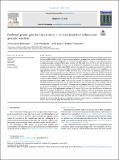Por favor, use este identificador para citar o enlazar a este item:
http://hdl.handle.net/10261/289570COMPARTIR / EXPORTAR:
 SHARE SHARE
 CORE
BASE CORE
BASE
|
|
| Visualizar otros formatos: MARC | Dublin Core | RDF | ORE | MODS | METS | DIDL | DATACITE | |

| Título: | Predicted genetic gain for carcass yield in rainbow trout from indirect and genomic selection |
Autor: | García-Ballesteros, Silvia; Fernández, Jesús CSIC ORCID; Kause, Antti; Villanueva, Beatriz | Palabras clave: | Carcass yield Fillet yield Sib selection Indirect selection Genomic selection |
Fecha de publicación: | 3-mar-2022 | Editor: | Elsevier | Citación: | Aquaculture 554 (2022) 738119 | Resumen: | Carcass and fillet yields are traits of great economic importance in aquaculture species, including rainbow trout. Headless gutted carcass percentage (HC) is a convenient selection criterion to improve carcass yield given that it is highly genetically correlated with the latter and also with fillet yield. However, HC is a sib trait that cannot be recorded on selection candidates. Consequently, the within-family component of the genetic variance cannot be exploited with traditional pedigree-based BLUP selection. Two alternatives to exploit this component would be to select directly on an indicator trait genetically correlated with HC that can be recorded on live candidates or to apply genomic selection. The objective of this simulation study was to predict the phenotypic gains for HC in rainbow trout breeding programs when four alternative selection strategies are used: i) sib selection for HC, ii) indirect selection for a morphological indicator recorded in vivo; iii) genomic selection for HC; and iv) genomic selection for the indicator. Also, the four strategies were compared in a multitrait selection scenario where body weight was also included in the breeding objective. The different scenarios were compared at the same selection intensity and number of records (2000) for HC (on sibs) and IHC (on candidates). Two different heritabilities for HC (0.55 and 0.25) were considered. For the highest heritability, the phenotypic gain for HC was higher with sib than with indirect selection for both BLUP (1.03 versus 0.98) and genomic selection (1.22 versus 1.04). However, for the lowest heritability, the phenotypic gain for HC was lower with sib than with indirect selection for both BLUP (0.60 versus 0.64) and genomic selection (0.70 versus 0.71). In any case, the differences in phenotypic gains for HC between sib and indirect selection were not large. Therefore, given that sib selection implies extra costs associated with maintaining and genotyping sibs and indirect selection allows higher selection intensity for a given number of fish, indirect selection appears to be a more cost-effective option. The patterns found for single trait selection were maintained when the yield trait (HC or indicator) was selected simultaneously with body weight. We conclude that the optimum approach to improve carcass yield is a combination of genomic and indirect selection in both single and multitrait selection scenarios. | URI: | http://hdl.handle.net/10261/289570 | DOI: | 10.1016/j.aquaculture.2022.738119 | ISSN: | 0044-8486 |
| Aparece en las colecciones: | (INIA) Artículos |
Ficheros en este ítem:
| Fichero | Descripción | Tamaño | Formato | |
|---|---|---|---|---|
| 1-s2.0-S0044848622002356-main.pdf | 529,46 kB | Adobe PDF |  Visualizar/Abrir |
CORE Recommender
SCOPUSTM
Citations
6
checked on 12-may-2024
WEB OF SCIENCETM
Citations
4
checked on 28-feb-2024
Page view(s)
31
checked on 16-may-2024
Download(s)
38
checked on 16-may-2024
Google ScholarTM
Check
Altmetric
Altmetric
Este item está licenciado bajo una Licencia Creative Commons

